Assessment of Trending Technologies Report: University Name
VerifiedAdded on 2021/04/24
|13
|2361
|31
Report
AI Summary
This report provides an assessment of several trending technologies, including 3D printing, virtual reality (VR), and green computing. The 3D printing section introduces the technology, its requirements (software and hardware), advantages (resource efficiency, customization), and disadvantages (bugs, time-consuming processes). The VR segment discusses the evolution of digital communication, highlighting VR's impact on digital society and its potential to enhance communication through platforms like Facebook Spaces. The report also explores the application of green computing techniques in data center design, emphasizing the importance of energy efficiency, resource sustainability, and reduced environmental impact. The report details the design considerations for data centers, including layout, equipment placement, and cooling efficiency, all aimed at minimizing energy consumption and promoting eco-friendly practices. The report concludes by emphasizing the potential of each technology and the need to address limitations for optimal use.
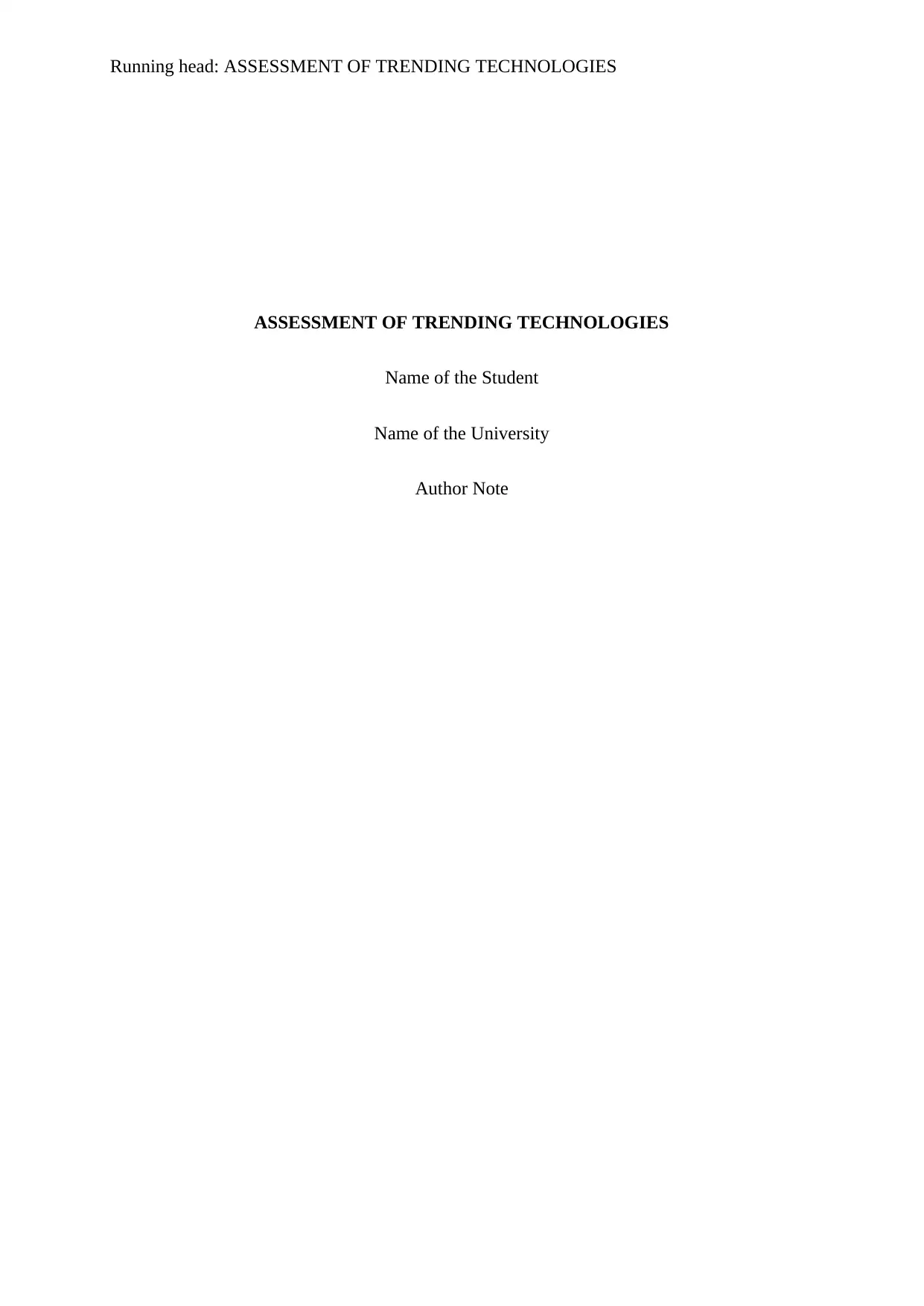
Running head: ASSESSMENT OF TRENDING TECHNOLOGIES
ASSESSMENT OF TRENDING TECHNOLOGIES
Name of the Student
Name of the University
Author Note
ASSESSMENT OF TRENDING TECHNOLOGIES
Name of the Student
Name of the University
Author Note
Paraphrase This Document
Need a fresh take? Get an instant paraphrase of this document with our AI Paraphraser

1ASSESSMENT OF TRENDING TECHNOLOGIES
Table of Contents
3D-Printer:..................................................................................................................................2
Introduction:............................................................................................................................2
Requirements:..........................................................................................................................3
Advantages and Disadvantages:..............................................................................................5
Conclusion:..............................................................................................................................7
Evolution and Future of Digital Communication as Virtual Reality:.........................................7
Impact of Virtual Reality on Digital Society:.............................................................................8
Adopting green computing techniques to Data Centre Designing:............................................9
Data centre design using the green computing techniques:......................................................10
References:................................................................................................................................11
Table of Contents
3D-Printer:..................................................................................................................................2
Introduction:............................................................................................................................2
Requirements:..........................................................................................................................3
Advantages and Disadvantages:..............................................................................................5
Conclusion:..............................................................................................................................7
Evolution and Future of Digital Communication as Virtual Reality:.........................................7
Impact of Virtual Reality on Digital Society:.............................................................................8
Adopting green computing techniques to Data Centre Designing:............................................9
Data centre design using the green computing techniques:......................................................10
References:................................................................................................................................11
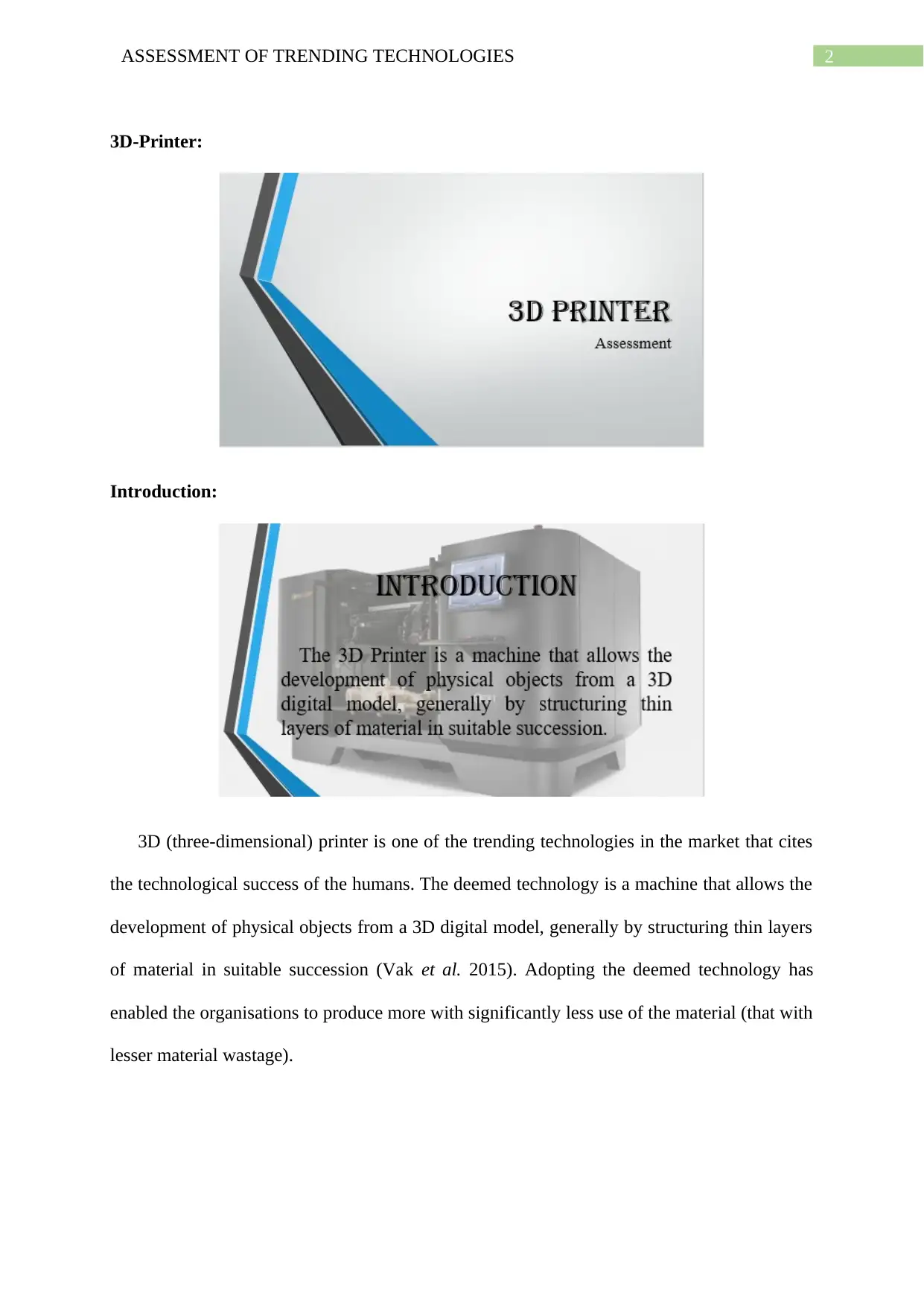
2ASSESSMENT OF TRENDING TECHNOLOGIES
3D-Printer:
Introduction:
3D (three-dimensional) printer is one of the trending technologies in the market that cites
the technological success of the humans. The deemed technology is a machine that allows the
development of physical objects from a 3D digital model, generally by structuring thin layers
of material in suitable succession (Vak et al. 2015). Adopting the deemed technology has
enabled the organisations to produce more with significantly less use of the material (that with
lesser material wastage).
3D-Printer:
Introduction:
3D (three-dimensional) printer is one of the trending technologies in the market that cites
the technological success of the humans. The deemed technology is a machine that allows the
development of physical objects from a 3D digital model, generally by structuring thin layers
of material in suitable succession (Vak et al. 2015). Adopting the deemed technology has
enabled the organisations to produce more with significantly less use of the material (that with
lesser material wastage).
⊘ This is a preview!⊘
Do you want full access?
Subscribe today to unlock all pages.

Trusted by 1+ million students worldwide

3ASSESSMENT OF TRENDING TECHNOLOGIES
Requirements:
The deemed section offers an insight into the minimum requirements for the 3D Printer
and has also mentioned the most suitable recommendation for the same has also been
mentioned in the following tables (Pearce 2012).
Software Minimum Recommended
Windows
OS
Windows 7
[.NET Framework Version 4.5 or higher]
Windows 8, Windows 10
[.NET Framework Version 4.5
or higher]
MAC OS Mavericks (10.9) El Capitan (10.11)
[newer patches may cause
Requirements:
The deemed section offers an insight into the minimum requirements for the 3D Printer
and has also mentioned the most suitable recommendation for the same has also been
mentioned in the following tables (Pearce 2012).
Software Minimum Recommended
Windows
OS
Windows 7
[.NET Framework Version 4.5 or higher]
Windows 8, Windows 10
[.NET Framework Version 4.5
or higher]
MAC OS Mavericks (10.9) El Capitan (10.11)
[newer patches may cause
Paraphrase This Document
Need a fresh take? Get an instant paraphrase of this document with our AI Paraphraser

4ASSESSMENT OF TRENDING TECHNOLOGIES
software issues]
Table 1: Software requirement of the 3D Printer
(Source: Created by Author)
Hardware Minimum Recommended
Processor 32 bit dual core CPU 64 bit quad core CPU
Memory 4 GB >8 GB
Graphics
Card
OpenGL card with 500 MB video
RAM
OpenGL card with >1 GB video
RAM
software issues]
Table 1: Software requirement of the 3D Printer
(Source: Created by Author)
Hardware Minimum Recommended
Processor 32 bit dual core CPU 64 bit quad core CPU
Memory 4 GB >8 GB
Graphics
Card
OpenGL card with 500 MB video
RAM
OpenGL card with >1 GB video
RAM

5ASSESSMENT OF TRENDING TECHNOLOGIES
Display 800x600, 24-bit color
Table 2: Hardware requirement of the 3D Printer
(Source: Created by Author)
Additional requirements for the operation of the 3D printer has been mentioned as
follows:
POWER: To energise the printer.
USB CONNECTION: To connect the printer to the computing systems.
Advantages and Disadvantages:
The pros and cons of the subject of the paper have been discussed as follows:
Advantages: The following points refers to the most advantageous assessment that 3D
Printer can offer to the manufacturing industry:
The technology prevents wastage of resources and also saves money in the
expensive tools required for the process (Conner et al. 2014).
One of the most noted advantage offered by the deemed technology is the
customisation of the produced goods which leads to customer satisfaction.
Display 800x600, 24-bit color
Table 2: Hardware requirement of the 3D Printer
(Source: Created by Author)
Additional requirements for the operation of the 3D printer has been mentioned as
follows:
POWER: To energise the printer.
USB CONNECTION: To connect the printer to the computing systems.
Advantages and Disadvantages:
The pros and cons of the subject of the paper have been discussed as follows:
Advantages: The following points refers to the most advantageous assessment that 3D
Printer can offer to the manufacturing industry:
The technology prevents wastage of resources and also saves money in the
expensive tools required for the process (Conner et al. 2014).
One of the most noted advantage offered by the deemed technology is the
customisation of the produced goods which leads to customer satisfaction.
⊘ This is a preview!⊘
Do you want full access?
Subscribe today to unlock all pages.

Trusted by 1+ million students worldwide
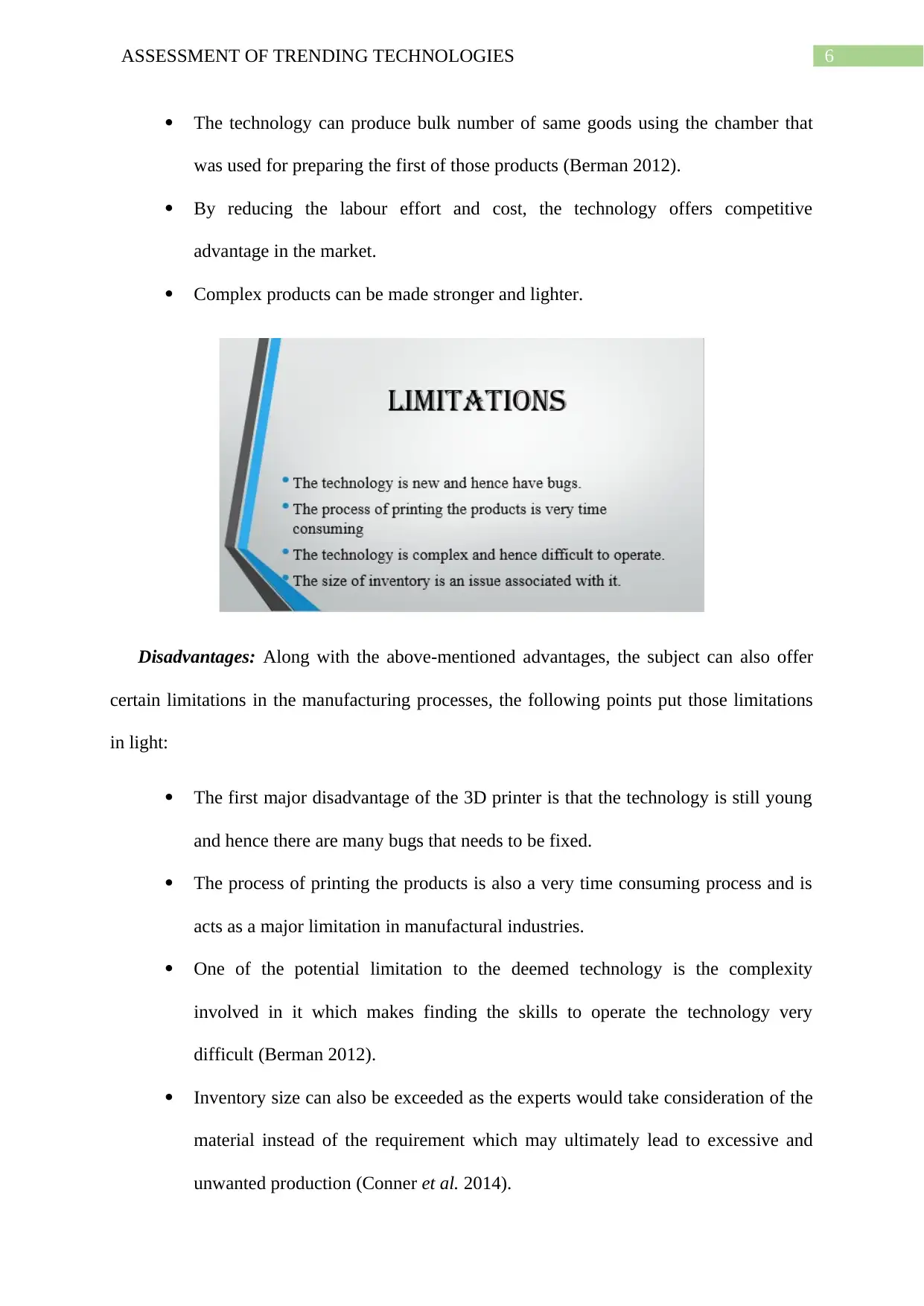
6ASSESSMENT OF TRENDING TECHNOLOGIES
The technology can produce bulk number of same goods using the chamber that
was used for preparing the first of those products (Berman 2012).
By reducing the labour effort and cost, the technology offers competitive
advantage in the market.
Complex products can be made stronger and lighter.
Disadvantages: Along with the above-mentioned advantages, the subject can also offer
certain limitations in the manufacturing processes, the following points put those limitations
in light:
The first major disadvantage of the 3D printer is that the technology is still young
and hence there are many bugs that needs to be fixed.
The process of printing the products is also a very time consuming process and is
acts as a major limitation in manufactural industries.
One of the potential limitation to the deemed technology is the complexity
involved in it which makes finding the skills to operate the technology very
difficult (Berman 2012).
Inventory size can also be exceeded as the experts would take consideration of the
material instead of the requirement which may ultimately lead to excessive and
unwanted production (Conner et al. 2014).
The technology can produce bulk number of same goods using the chamber that
was used for preparing the first of those products (Berman 2012).
By reducing the labour effort and cost, the technology offers competitive
advantage in the market.
Complex products can be made stronger and lighter.
Disadvantages: Along with the above-mentioned advantages, the subject can also offer
certain limitations in the manufacturing processes, the following points put those limitations
in light:
The first major disadvantage of the 3D printer is that the technology is still young
and hence there are many bugs that needs to be fixed.
The process of printing the products is also a very time consuming process and is
acts as a major limitation in manufactural industries.
One of the potential limitation to the deemed technology is the complexity
involved in it which makes finding the skills to operate the technology very
difficult (Berman 2012).
Inventory size can also be exceeded as the experts would take consideration of the
material instead of the requirement which may ultimately lead to excessive and
unwanted production (Conner et al. 2014).
Paraphrase This Document
Need a fresh take? Get an instant paraphrase of this document with our AI Paraphraser
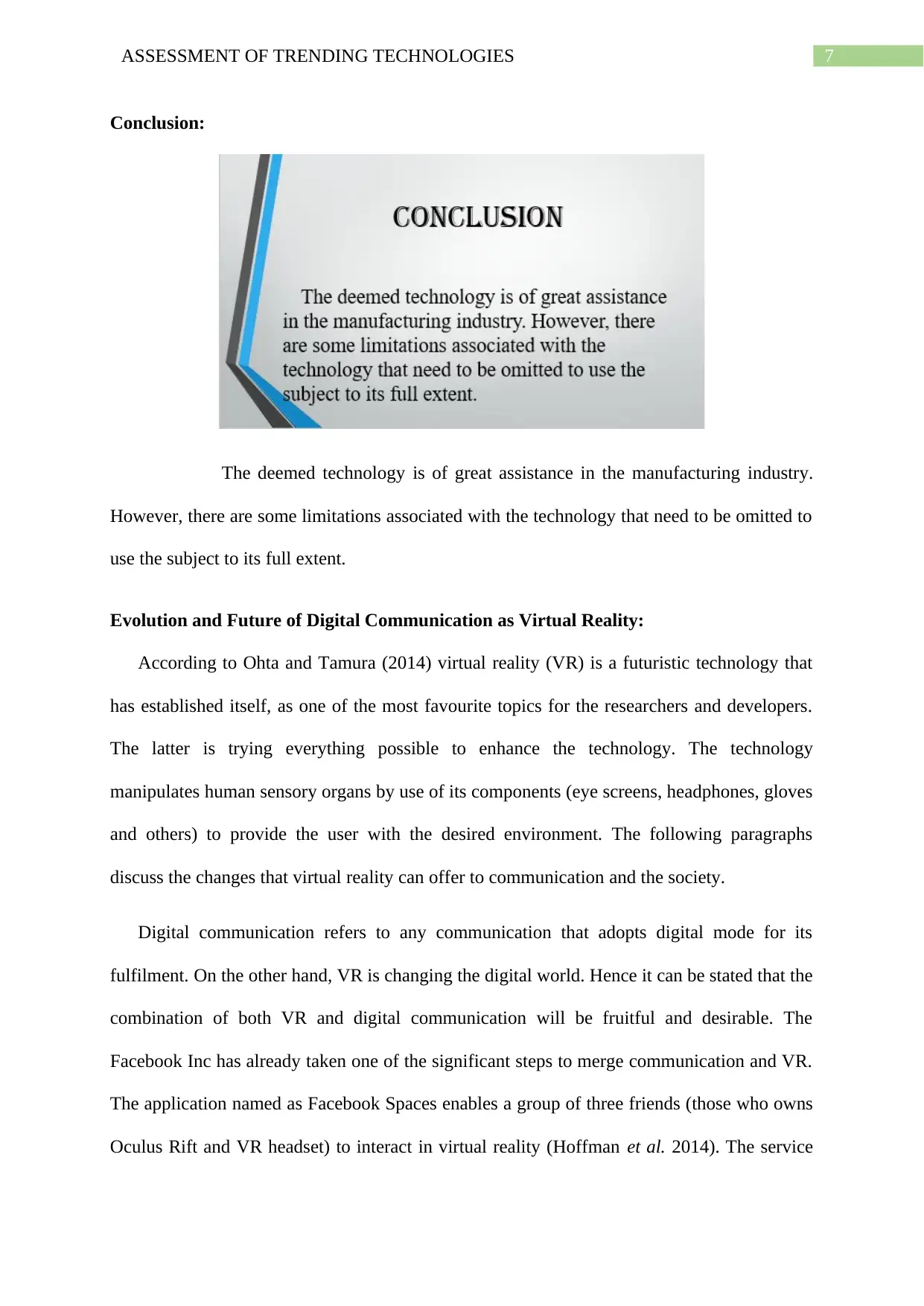
7ASSESSMENT OF TRENDING TECHNOLOGIES
Conclusion:
The deemed technology is of great assistance in the manufacturing industry.
However, there are some limitations associated with the technology that need to be omitted to
use the subject to its full extent.
Evolution and Future of Digital Communication as Virtual Reality:
According to Ohta and Tamura (2014) virtual reality (VR) is a futuristic technology that
has established itself, as one of the most favourite topics for the researchers and developers.
The latter is trying everything possible to enhance the technology. The technology
manipulates human sensory organs by use of its components (eye screens, headphones, gloves
and others) to provide the user with the desired environment. The following paragraphs
discuss the changes that virtual reality can offer to communication and the society.
Digital communication refers to any communication that adopts digital mode for its
fulfilment. On the other hand, VR is changing the digital world. Hence it can be stated that the
combination of both VR and digital communication will be fruitful and desirable. The
Facebook Inc has already taken one of the significant steps to merge communication and VR.
The application named as Facebook Spaces enables a group of three friends (those who owns
Oculus Rift and VR headset) to interact in virtual reality (Hoffman et al. 2014). The service
Conclusion:
The deemed technology is of great assistance in the manufacturing industry.
However, there are some limitations associated with the technology that need to be omitted to
use the subject to its full extent.
Evolution and Future of Digital Communication as Virtual Reality:
According to Ohta and Tamura (2014) virtual reality (VR) is a futuristic technology that
has established itself, as one of the most favourite topics for the researchers and developers.
The latter is trying everything possible to enhance the technology. The technology
manipulates human sensory organs by use of its components (eye screens, headphones, gloves
and others) to provide the user with the desired environment. The following paragraphs
discuss the changes that virtual reality can offer to communication and the society.
Digital communication refers to any communication that adopts digital mode for its
fulfilment. On the other hand, VR is changing the digital world. Hence it can be stated that the
combination of both VR and digital communication will be fruitful and desirable. The
Facebook Inc has already taken one of the significant steps to merge communication and VR.
The application named as Facebook Spaces enables a group of three friends (those who owns
Oculus Rift and VR headset) to interact in virtual reality (Hoffman et al. 2014). The service
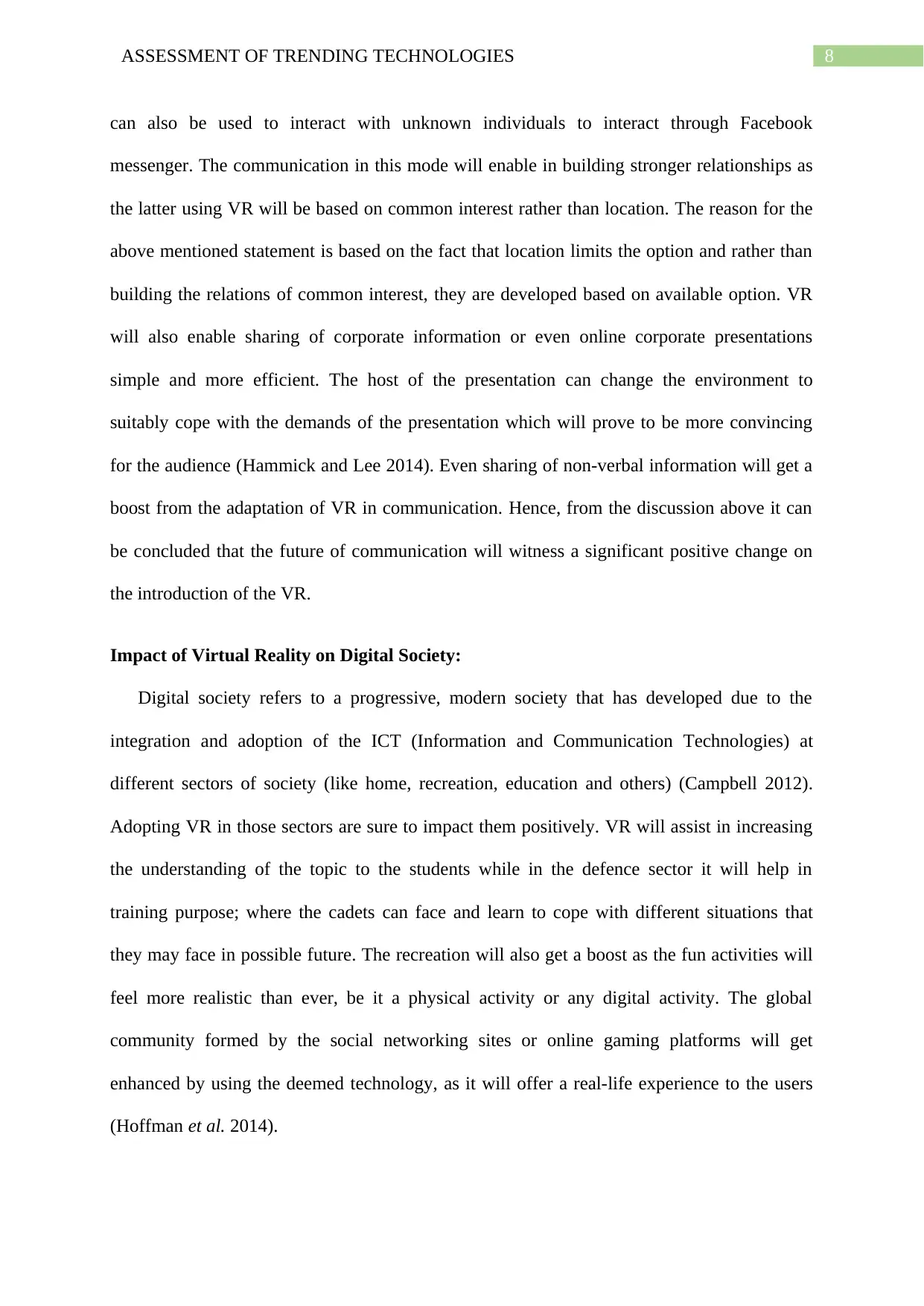
8ASSESSMENT OF TRENDING TECHNOLOGIES
can also be used to interact with unknown individuals to interact through Facebook
messenger. The communication in this mode will enable in building stronger relationships as
the latter using VR will be based on common interest rather than location. The reason for the
above mentioned statement is based on the fact that location limits the option and rather than
building the relations of common interest, they are developed based on available option. VR
will also enable sharing of corporate information or even online corporate presentations
simple and more efficient. The host of the presentation can change the environment to
suitably cope with the demands of the presentation which will prove to be more convincing
for the audience (Hammick and Lee 2014). Even sharing of non-verbal information will get a
boost from the adaptation of VR in communication. Hence, from the discussion above it can
be concluded that the future of communication will witness a significant positive change on
the introduction of the VR.
Impact of Virtual Reality on Digital Society:
Digital society refers to a progressive, modern society that has developed due to the
integration and adoption of the ICT (Information and Communication Technologies) at
different sectors of society (like home, recreation, education and others) (Campbell 2012).
Adopting VR in those sectors are sure to impact them positively. VR will assist in increasing
the understanding of the topic to the students while in the defence sector it will help in
training purpose; where the cadets can face and learn to cope with different situations that
they may face in possible future. The recreation will also get a boost as the fun activities will
feel more realistic than ever, be it a physical activity or any digital activity. The global
community formed by the social networking sites or online gaming platforms will get
enhanced by using the deemed technology, as it will offer a real-life experience to the users
(Hoffman et al. 2014).
can also be used to interact with unknown individuals to interact through Facebook
messenger. The communication in this mode will enable in building stronger relationships as
the latter using VR will be based on common interest rather than location. The reason for the
above mentioned statement is based on the fact that location limits the option and rather than
building the relations of common interest, they are developed based on available option. VR
will also enable sharing of corporate information or even online corporate presentations
simple and more efficient. The host of the presentation can change the environment to
suitably cope with the demands of the presentation which will prove to be more convincing
for the audience (Hammick and Lee 2014). Even sharing of non-verbal information will get a
boost from the adaptation of VR in communication. Hence, from the discussion above it can
be concluded that the future of communication will witness a significant positive change on
the introduction of the VR.
Impact of Virtual Reality on Digital Society:
Digital society refers to a progressive, modern society that has developed due to the
integration and adoption of the ICT (Information and Communication Technologies) at
different sectors of society (like home, recreation, education and others) (Campbell 2012).
Adopting VR in those sectors are sure to impact them positively. VR will assist in increasing
the understanding of the topic to the students while in the defence sector it will help in
training purpose; where the cadets can face and learn to cope with different situations that
they may face in possible future. The recreation will also get a boost as the fun activities will
feel more realistic than ever, be it a physical activity or any digital activity. The global
community formed by the social networking sites or online gaming platforms will get
enhanced by using the deemed technology, as it will offer a real-life experience to the users
(Hoffman et al. 2014).
⊘ This is a preview!⊘
Do you want full access?
Subscribe today to unlock all pages.

Trusted by 1+ million students worldwide
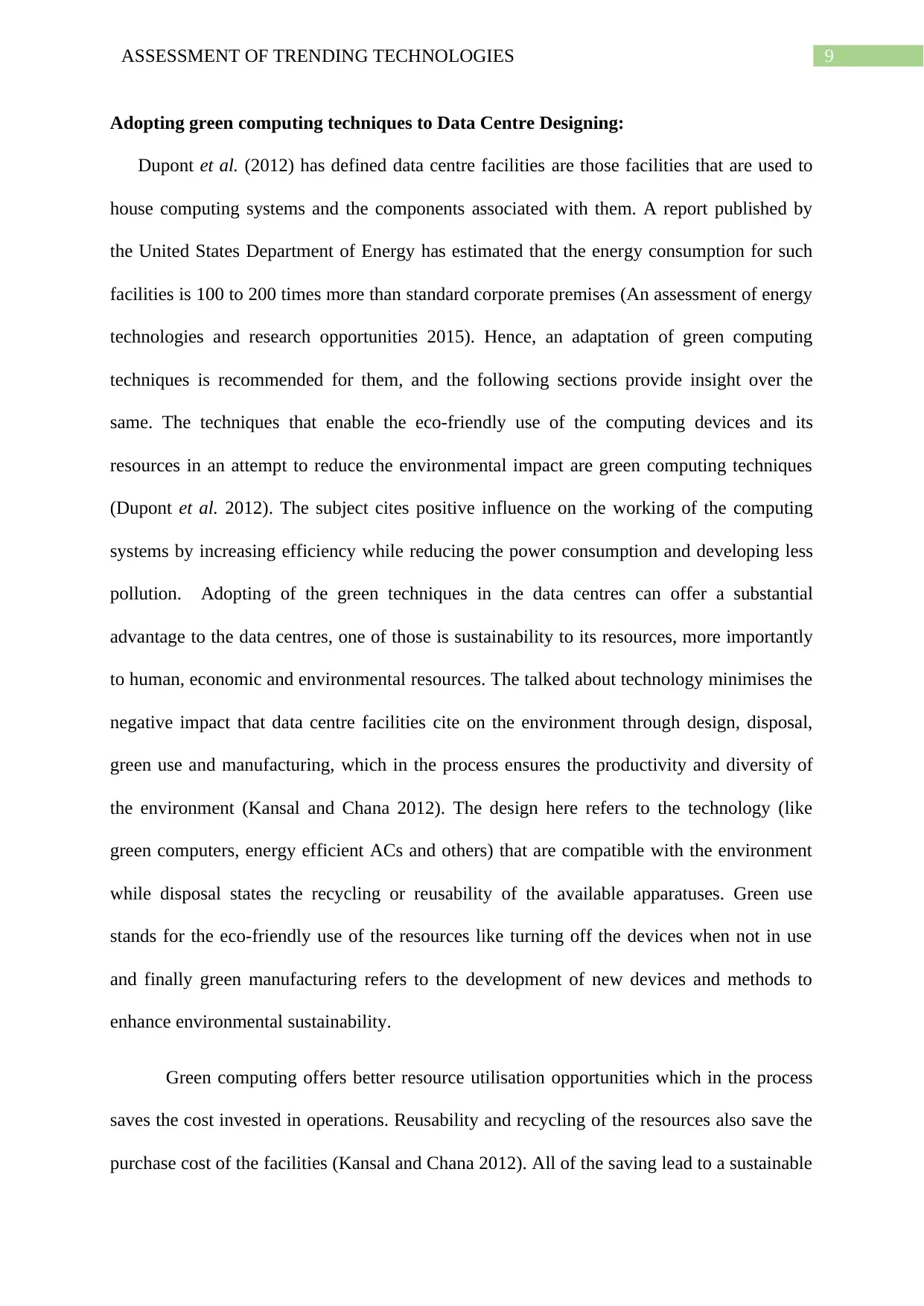
9ASSESSMENT OF TRENDING TECHNOLOGIES
Adopting green computing techniques to Data Centre Designing:
Dupont et al. (2012) has defined data centre facilities are those facilities that are used to
house computing systems and the components associated with them. A report published by
the United States Department of Energy has estimated that the energy consumption for such
facilities is 100 to 200 times more than standard corporate premises (An assessment of energy
technologies and research opportunities 2015). Hence, an adaptation of green computing
techniques is recommended for them, and the following sections provide insight over the
same. The techniques that enable the eco-friendly use of the computing devices and its
resources in an attempt to reduce the environmental impact are green computing techniques
(Dupont et al. 2012). The subject cites positive influence on the working of the computing
systems by increasing efficiency while reducing the power consumption and developing less
pollution. Adopting of the green techniques in the data centres can offer a substantial
advantage to the data centres, one of those is sustainability to its resources, more importantly
to human, economic and environmental resources. The talked about technology minimises the
negative impact that data centre facilities cite on the environment through design, disposal,
green use and manufacturing, which in the process ensures the productivity and diversity of
the environment (Kansal and Chana 2012). The design here refers to the technology (like
green computers, energy efficient ACs and others) that are compatible with the environment
while disposal states the recycling or reusability of the available apparatuses. Green use
stands for the eco-friendly use of the resources like turning off the devices when not in use
and finally green manufacturing refers to the development of new devices and methods to
enhance environmental sustainability.
Green computing offers better resource utilisation opportunities which in the process
saves the cost invested in operations. Reusability and recycling of the resources also save the
purchase cost of the facilities (Kansal and Chana 2012). All of the saving lead to a sustainable
Adopting green computing techniques to Data Centre Designing:
Dupont et al. (2012) has defined data centre facilities are those facilities that are used to
house computing systems and the components associated with them. A report published by
the United States Department of Energy has estimated that the energy consumption for such
facilities is 100 to 200 times more than standard corporate premises (An assessment of energy
technologies and research opportunities 2015). Hence, an adaptation of green computing
techniques is recommended for them, and the following sections provide insight over the
same. The techniques that enable the eco-friendly use of the computing devices and its
resources in an attempt to reduce the environmental impact are green computing techniques
(Dupont et al. 2012). The subject cites positive influence on the working of the computing
systems by increasing efficiency while reducing the power consumption and developing less
pollution. Adopting of the green techniques in the data centres can offer a substantial
advantage to the data centres, one of those is sustainability to its resources, more importantly
to human, economic and environmental resources. The talked about technology minimises the
negative impact that data centre facilities cite on the environment through design, disposal,
green use and manufacturing, which in the process ensures the productivity and diversity of
the environment (Kansal and Chana 2012). The design here refers to the technology (like
green computers, energy efficient ACs and others) that are compatible with the environment
while disposal states the recycling or reusability of the available apparatuses. Green use
stands for the eco-friendly use of the resources like turning off the devices when not in use
and finally green manufacturing refers to the development of new devices and methods to
enhance environmental sustainability.
Green computing offers better resource utilisation opportunities which in the process
saves the cost invested in operations. Reusability and recycling of the resources also save the
purchase cost of the facilities (Kansal and Chana 2012). All of the saving lead to a sustainable
Paraphrase This Document
Need a fresh take? Get an instant paraphrase of this document with our AI Paraphraser
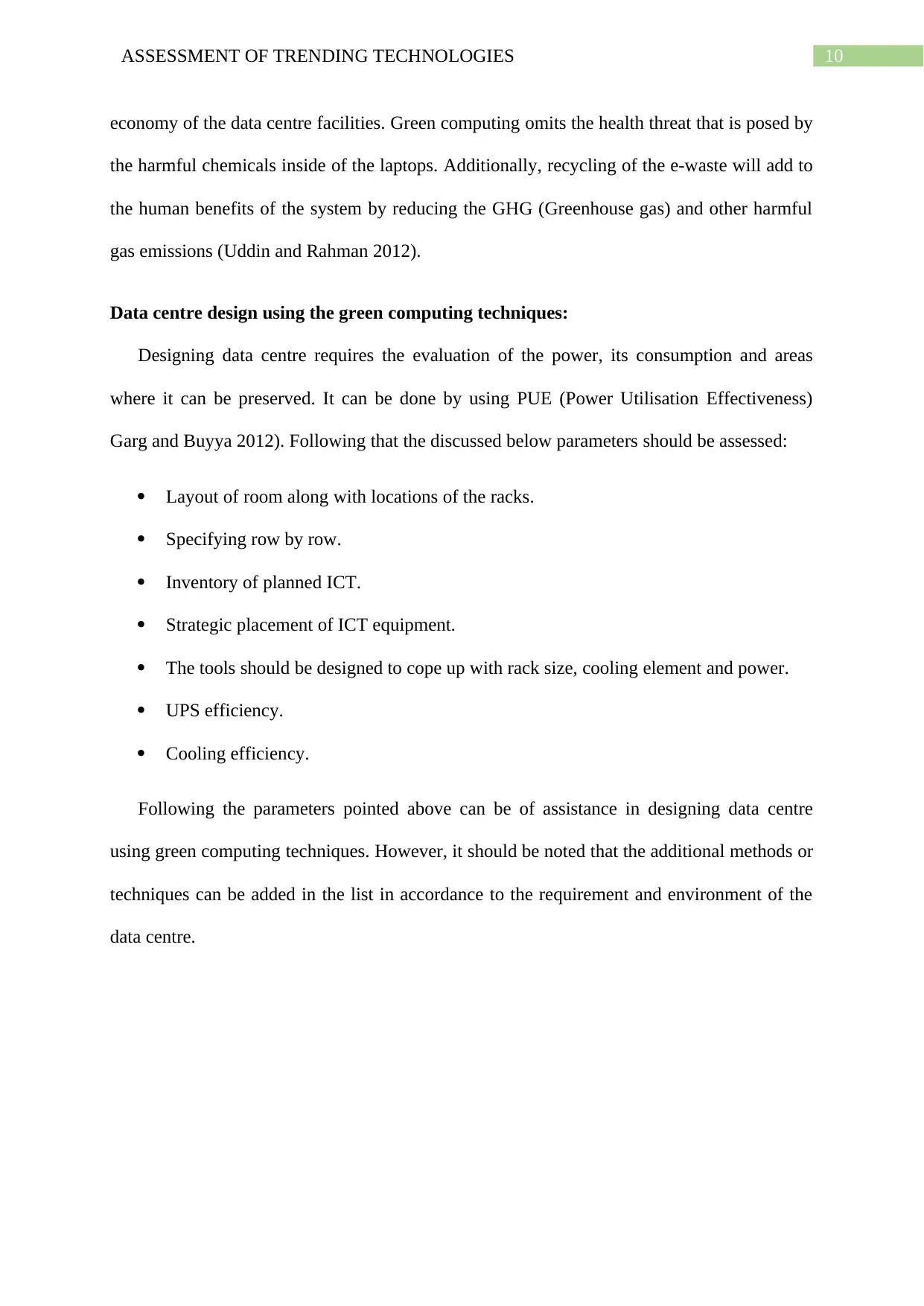
10ASSESSMENT OF TRENDING TECHNOLOGIES
economy of the data centre facilities. Green computing omits the health threat that is posed by
the harmful chemicals inside of the laptops. Additionally, recycling of the e-waste will add to
the human benefits of the system by reducing the GHG (Greenhouse gas) and other harmful
gas emissions (Uddin and Rahman 2012).
Data centre design using the green computing techniques:
Designing data centre requires the evaluation of the power, its consumption and areas
where it can be preserved. It can be done by using PUE (Power Utilisation Effectiveness)
Garg and Buyya 2012). Following that the discussed below parameters should be assessed:
Layout of room along with locations of the racks.
Specifying row by row.
Inventory of planned ICT.
Strategic placement of ICT equipment.
The tools should be designed to cope up with rack size, cooling element and power.
UPS efficiency.
Cooling efficiency.
Following the parameters pointed above can be of assistance in designing data centre
using green computing techniques. However, it should be noted that the additional methods or
techniques can be added in the list in accordance to the requirement and environment of the
data centre.
economy of the data centre facilities. Green computing omits the health threat that is posed by
the harmful chemicals inside of the laptops. Additionally, recycling of the e-waste will add to
the human benefits of the system by reducing the GHG (Greenhouse gas) and other harmful
gas emissions (Uddin and Rahman 2012).
Data centre design using the green computing techniques:
Designing data centre requires the evaluation of the power, its consumption and areas
where it can be preserved. It can be done by using PUE (Power Utilisation Effectiveness)
Garg and Buyya 2012). Following that the discussed below parameters should be assessed:
Layout of room along with locations of the racks.
Specifying row by row.
Inventory of planned ICT.
Strategic placement of ICT equipment.
The tools should be designed to cope up with rack size, cooling element and power.
UPS efficiency.
Cooling efficiency.
Following the parameters pointed above can be of assistance in designing data centre
using green computing techniques. However, it should be noted that the additional methods or
techniques can be added in the list in accordance to the requirement and environment of the
data centre.
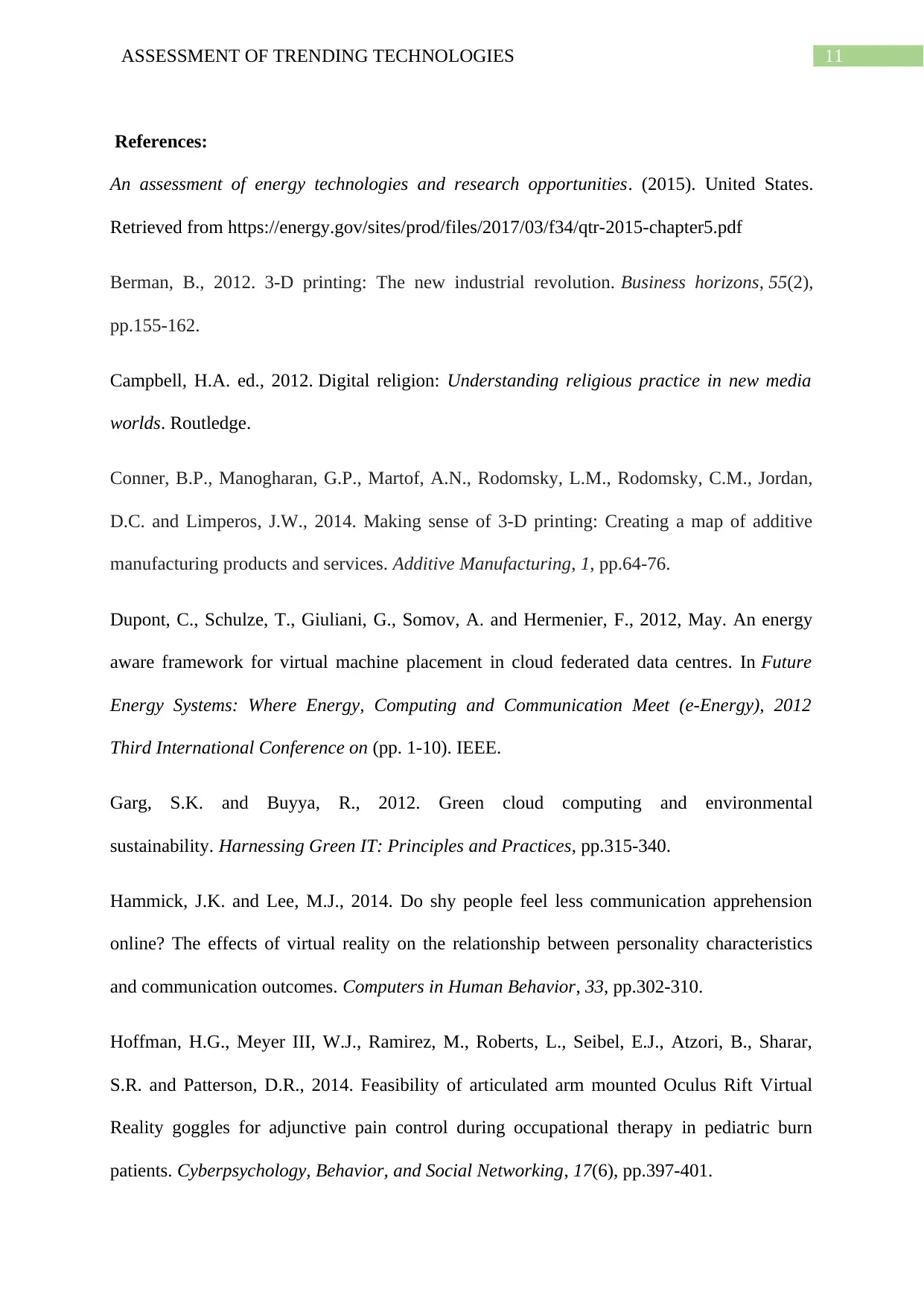
11ASSESSMENT OF TRENDING TECHNOLOGIES
References:
An assessment of energy technologies and research opportunities. (2015). United States.
Retrieved from https://energy.gov/sites/prod/files/2017/03/f34/qtr-2015-chapter5.pdf
Berman, B., 2012. 3-D printing: The new industrial revolution. Business horizons, 55(2),
pp.155-162.
Campbell, H.A. ed., 2012. Digital religion: Understanding religious practice in new media
worlds. Routledge.
Conner, B.P., Manogharan, G.P., Martof, A.N., Rodomsky, L.M., Rodomsky, C.M., Jordan,
D.C. and Limperos, J.W., 2014. Making sense of 3-D printing: Creating a map of additive
manufacturing products and services. Additive Manufacturing, 1, pp.64-76.
Dupont, C., Schulze, T., Giuliani, G., Somov, A. and Hermenier, F., 2012, May. An energy
aware framework for virtual machine placement in cloud federated data centres. In Future
Energy Systems: Where Energy, Computing and Communication Meet (e-Energy), 2012
Third International Conference on (pp. 1-10). IEEE.
Garg, S.K. and Buyya, R., 2012. Green cloud computing and environmental
sustainability. Harnessing Green IT: Principles and Practices, pp.315-340.
Hammick, J.K. and Lee, M.J., 2014. Do shy people feel less communication apprehension
online? The effects of virtual reality on the relationship between personality characteristics
and communication outcomes. Computers in Human Behavior, 33, pp.302-310.
Hoffman, H.G., Meyer III, W.J., Ramirez, M., Roberts, L., Seibel, E.J., Atzori, B., Sharar,
S.R. and Patterson, D.R., 2014. Feasibility of articulated arm mounted Oculus Rift Virtual
Reality goggles for adjunctive pain control during occupational therapy in pediatric burn
patients. Cyberpsychology, Behavior, and Social Networking, 17(6), pp.397-401.
References:
An assessment of energy technologies and research opportunities. (2015). United States.
Retrieved from https://energy.gov/sites/prod/files/2017/03/f34/qtr-2015-chapter5.pdf
Berman, B., 2012. 3-D printing: The new industrial revolution. Business horizons, 55(2),
pp.155-162.
Campbell, H.A. ed., 2012. Digital religion: Understanding religious practice in new media
worlds. Routledge.
Conner, B.P., Manogharan, G.P., Martof, A.N., Rodomsky, L.M., Rodomsky, C.M., Jordan,
D.C. and Limperos, J.W., 2014. Making sense of 3-D printing: Creating a map of additive
manufacturing products and services. Additive Manufacturing, 1, pp.64-76.
Dupont, C., Schulze, T., Giuliani, G., Somov, A. and Hermenier, F., 2012, May. An energy
aware framework for virtual machine placement in cloud federated data centres. In Future
Energy Systems: Where Energy, Computing and Communication Meet (e-Energy), 2012
Third International Conference on (pp. 1-10). IEEE.
Garg, S.K. and Buyya, R., 2012. Green cloud computing and environmental
sustainability. Harnessing Green IT: Principles and Practices, pp.315-340.
Hammick, J.K. and Lee, M.J., 2014. Do shy people feel less communication apprehension
online? The effects of virtual reality on the relationship between personality characteristics
and communication outcomes. Computers in Human Behavior, 33, pp.302-310.
Hoffman, H.G., Meyer III, W.J., Ramirez, M., Roberts, L., Seibel, E.J., Atzori, B., Sharar,
S.R. and Patterson, D.R., 2014. Feasibility of articulated arm mounted Oculus Rift Virtual
Reality goggles for adjunctive pain control during occupational therapy in pediatric burn
patients. Cyberpsychology, Behavior, and Social Networking, 17(6), pp.397-401.
⊘ This is a preview!⊘
Do you want full access?
Subscribe today to unlock all pages.

Trusted by 1+ million students worldwide
1 out of 13